Ditapis dengan

Principles of Microeconomics
There is no such thing as a free lunch.
- Edisi
- -
- ISBN/ISSN
- 0-669-14492-4
- Deskripsi Fisik
- xxx, 625 hlm,; 25 cm
- Judul Seri
- -
- No. Panggil
- 338.5 HEN m

Microeconomics Theory and Applications
This book is written for students to help them learn intermediate microeconomics. I have attempted to combine a concise but rigorous presentation of microeconomics theory with real world applications of the theoretical tools developed in the text.
- Edisi
- -
- ISBN/ISSN
- 0-471-02462-7
- Deskripsi Fisik
- xxiv, 492 hlm,; 25 cm.
- Judul Seri
- -
- No. Panggil
- 330.1 AWH m
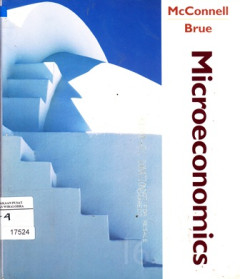
Microeconomics
- Edisi
- -
- ISBN/ISSN
- 978-0-07-290027-9
- Deskripsi Fisik
- xxiii, 833 hlm.; 26 cm
- Judul Seri
- -
- No. Panggil
- 338.5 BER m1
- Edisi
- -
- ISBN/ISSN
- 978-0-07-290027-9
- Deskripsi Fisik
- xxiii, 833 hlm.; 26 cm
- Judul Seri
- -
- No. Panggil
- 338.5 BER m1
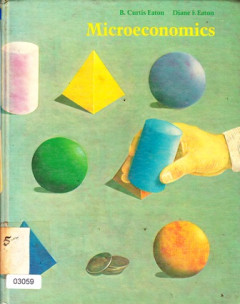
Microeconomics
Wea are all curious about our environment, and we want to understand it. economic provides a systematic way of understanding the economic activity that takes place in the world around us. Macroeconomics and microeconomics analiyze different aspect of that economic world; macroeconomics is concerned with larger economic system, and microeconomics with smaller units such as firm and households …
- Edisi
- -
- ISBN/ISSN
- 0-716-71818-9
- Deskripsi Fisik
- xv, 463 hlm.; 26 cm
- Judul Seri
- -
- No. Panggil
- 338.5 EAT m
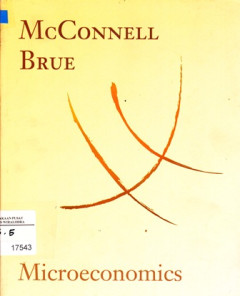
Microeconomics
MIcroecomonics reflects the challenge that specific topics and concept will likely pose for average students. for instance, the theory of the firm and macro output and price level determination are carefully treated. Here simplicity is corelated with comprehensivennes, not brevity.
- Edisi
- -
- ISBN/ISSN
- 0-07-234037-1
- Deskripsi Fisik
- xxiv, 514 hlm.; 25 cm
- Judul Seri
- -
- No. Panggil
- 338.5 MCC m1
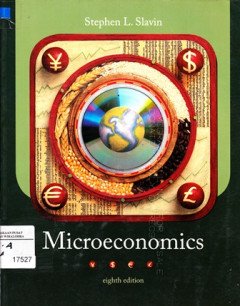
Microeconomics
Reading this book is like having a conversation with me. I'll be rigth there with you, illustrating various point with anecdot and asking you to work out numerical problems as we go along.
- Edisi
- 8
- ISBN/ISSN
- 978-0-07-328147-6
- Deskripsi Fisik
- xxi, 503 hlm.; 26 cm
- Judul Seri
- -
- No. Panggil
- 338.4 SLA s1

MIcroeconomics
We have three main goals for microeconomics: help the begining student master the principles essential for understanding the economizing problem, specific economic issues, and the policy alternative. help the students understand and apply the economics perspective and reason accurately and objectively about economic matters. Promote a lasting student interest in economics and the economy.
- Edisi
- -
- ISBN/ISSN
- 0-07-287561-5
- Deskripsi Fisik
- xiv, 487 hlm.; 25 cm
- Judul Seri
- -
- No. Panggil
- 338.4 MCC m1
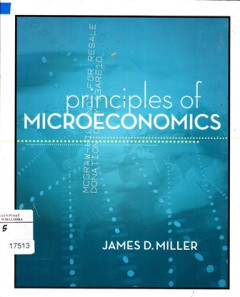
Principles of microeconomics
This approach to microeconomics is markedly different from many others currently in use, love it or hate it, my method diverges from the status quo in some fundamental ways. My hope is that student snd instructors alike will be engaged an dinspired by this text.
- Edisi
- -
- ISBN/ISSN
- 978-0-07-340283-3
- Deskripsi Fisik
- xxiv, 453 hlm.; 25 cm
- Judul Seri
- -
- No. Panggil
- 338.5 MIL p1
 Karya Umum
Karya Umum  Filsafat
Filsafat  Agama
Agama  Ilmu-ilmu Sosial
Ilmu-ilmu Sosial  Bahasa
Bahasa  Ilmu-ilmu Murni
Ilmu-ilmu Murni  Ilmu-ilmu Terapan
Ilmu-ilmu Terapan  Kesenian, Hiburan, dan Olahraga
Kesenian, Hiburan, dan Olahraga  Kesusastraan
Kesusastraan  Geografi dan Sejarah
Geografi dan Sejarah